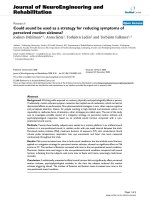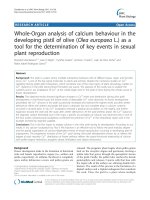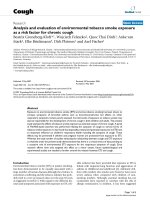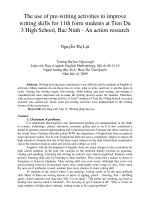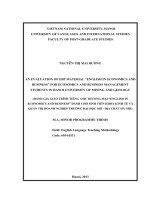AN EVALUATION OF “INTERACTIONS ACCESS READING” USED AS a TEXTBOOK FOR EFL COLLEGE STUDENTS AT CA MAU COMMUNITY COLLEGE
Bạn đang xem bản rút gọn của tài liệu. Xem và tải ngay bản đầy đủ của tài liệu tại đây (357.98 KB, 95 trang )
1
STATEMENT OF AUTHORSHIP
I certify that this thesis, entitled “An evaluation of
Interactions Access Reading used as a textbook for
EFL college students at Ca Mau Community College”,
is my own work.
Except where reference is made in the text of the
thesis, this thesis does not contain material published
elsewhere or extracted in whole or in part from a thesis by
which I have qualified for or been awarded another degree or
diploma.
No other person’s work has been used without due
acknowledgement in the main text of the thesis.
Vinh City, November
2016
2
ABSTRACT
The
study
evaluates
the
quality
of
the
textbook
Interactions Access Reading – Silver Edition for Ca Mau
Community College. The research was conducted in two
stages: a theoretical evaluation and an empirical evaluation.
The theoretical evaluation was based on the researcher’s
experience,
expertise,
and
the
literature
on
textbook
evaluation. The empirical evaluation was based on data
collected from 11 teachers and 83 students at CMCC in the
form of questionnaire and documents. The questionnaire
consisted of 22 grouped under 6 main categories: the general
appearance, design and illustration, accompanying materials,
objectives,
topic
appropriateness,
learning
components,
socio-cultural contexts, skills development, and teaching
methods. The evaluation sought to find out the users’ views
on the textbook, its impact on users and the users’
recommendations
for
improvement.
The
findings
were
generally in favor of the textbook except for the cover sheet,
difficulty of the activities and tasks is appropriate at learners’
level, the material for listening, speaking and natural
pronunciation. The category that had the highest percentage
was the one on teaching methods, while the category that
had the lowest mean was the one on learning components.
3
The findings also revealed that there were no significant
differences between the results of the two populations of the
study - teachers and students. And the study concluded with
recommendations and suggestions for the improvement of
the textbook.
ACKNOWLEDGEMENTS
Firstly, I would like to express my appreciation and
deeply-felt words to all those concerned in my thesis.
Secondly, my sincere gratitude goes to my supervisor,
Assoc. Prof., Ph.D. Ngo Dinh Phuong, who read my manuscript
with great care and devotion, gave thoughtful and insightful
comments, and provided me with invaluable support and
relevant materials in the preparation and completion this
thesis,
thus
asserting
his
indispensable
role
as
a
wholehearted supervisor. I would not have finished my study
without his enthusiastic guidance and constructive critical
questions to help me think over the problems.
Then my special thanks are reserved for my LA
classmates, who shared the happiness and difficulties with
me during the course. I will never forget the time I studied
with them, as siblings in a nice family.
4
I am also grateful to the managing board, the English
teaching staff, and the students in the academic year of
2015-2016 at Ca Mau Community College, whose willingness,
enthusiasm, and encouragement supported me so much.
Last but not least, words cannot reveal my appreciation
to my family. Without their endless love, I could never
overcome all the difficulties facing my life.
TABLE OF CONTENT
5
LIST OF TABLES
6
ABBREVIATIONS
CLT:
Communicative Language Teaching
CMCC:
Ca Mau Community college
ELT:
English language teaching
IELTS:
International English Language Testing
System
LA:
Long An
L1:
First Language
L2:
Second Language
MoET:
Ministry of Education and Training
PPP:
Presentation – Practice – Production
TOEFL:
Test of English as a Foreign Language
7
CHAPTER I. INTRODUCTION
This part will introduce the problem leading to the study,
purpose, scope, method, and organization of the study.
1.1.
Rationale
Since English is considered as today’s language of
international commerce and transaction, Viet Nam cannot
afford to be left out while its neighbors and countries around
the world are improving their English literacy. English enables
people in the world to communicate with each other as well
as do business and establish diplomacy, irrespective of any
political systems, races and religions. Since 1986, the
Vietnamese government initiated an “open door” policy to
establish diplomatic relations with countries all over the
world, English has been more important than ever.
Many English textbooks have been used in Viet Nam in
general and in Ca Mau Community college in particular.
However, the question “How to make English teaching and
learning effective?” remains a concern for the government,
educational
officials,
administrators
and
teachers.
Most
curriculum and textbooks reform over the years have required
to make a critical re-examination of aims, goals, objectives,
method and materials. In fact, one school of thought in
curriculum development states that the achieved curriculum
is the effective one. To determine whether or not the
curriculum is achieved, evaluation is the measure. Evaluation,
8
therefore, is a key factor in curriculum development and
implementation.
Besides, materials evaluation is an educational necessity
because it shows how a textbook can be improved or justified.
Teaching materials have a direct influence on the process of
learning and teaching. Nunan (1988) states that: materials
are, in fact, an essential element within the curriculum, and
do more than simply lubricate the wheels of learning. At their
best, they provide concrete models for desirable classroom
practice. They act as curriculum models and at their very best
they fulfill a teacher development role (Nunan, 1988, p. 98).
The reasons above motivated the researcher to evaluate
the
English
language
textbook
studied
at
CMCC.
The
significance of this choice is that this textbook has been used
at CMCC for a long time and evaluating it will be an urgent
need and of a great value. The evaluation can provide a
reference for the subsequent revisions and improvement of
certain aspects of this fundamental textbook and related
material as well.
Another
reason
is
that
this
book
constitutes
the
curriculum for English language education in CMCC. Although
it is true that many studies have dealt with evaluating English
textbooks, these are still inadequate, and there have so far
been no studies evaluating this Interactions Access Reading
textbook in CMCC.
The current study is an attempt to evaluate Interactions
Access Reading textbook, which is the first in the series, for
9
beginners of English; a related objective is to establish a basic
foundation for the evaluation of the other textbooks in the
series.
1.2.
Aims and objectives of the study
Given the background together with its gap as identified
and presented above, this study aims to investigate the
strengths and weaknesses of reading materials in the
Interactions Access Reading textbook to help improve the
quality of English teaching and learning in CMCC.
1.3.
Research questions
To achieve the aim articulated above, this thesis will try
to find the information to answer the following research
question:
1. What is the quality of the textbook? Is it appropriate
to language teaching and the learning context in CMCC?
2. How do teachers and students assess the quality of
the textbook?
3. What recommendations do the teachers and students
make for improving the textbook?
1.4.
Methods of the study
The study is carried out by using both qualitative and
quantitative methods including questionnaires and interviews.
- Collecting information associated with reading skills
and activities from the textbook
- Investigating and analyzing the situation of teaching
and learning reading skills and using activities in reading class
at CMCC.
10
- Synthesizing and analyzing the results gained in
investigating duration to suggest suitable activities and
materials for reading class.
1.5.
Scope of the study
Due to a limitation of a graduation thesis, the study only
concerns the texts on Interactions Access Reading and the
subjects of the research are the teachers and students at Ca
Mau Community College.
1.6.
Design of the study
The thesis is structured as follows:
Chapter 1 problematizes the object of the study. To do
this, it deals with the six parts of rationale, aims and
objectives of the study, research questions, and methods of
the study, scope of the study focus and design of the study.
Chapter
2
contains
the
literature
review,
with
a
discussion of textbooks, textbook design, textbook evaluation
and the evaluation criteria used in this research. This chapter
also reviews some previous research studies on textbook
evaluation.
Chapter 3 deals with research design and methodology
employed to carry out the research. It describes four main
issues regarding the research site, participants, data types
and methods of data collection, and analytical framework.
Chapter 4 analyses and discusses the findings grounded
in the data analyzed in the previous chapter.
Chapter 5 will be summarized the main points and
contents of the study based on the results of the study. The
11
implication of the study and the recommendation for further
research will be presented.
12
CHAPTER II. LITERATURE REVIEW AND
THEORETICAL BACKGROUND
As presented in the previous chapter, the evaluation of
the English textbook, especially the reading skill, after more
than one year in use is an urgent requirement to help improve
the teaching and learning quality in CMCC in Vietnam.
However, there has been a lack of a systematic and reliable
set of criteria for textbook evaluation in general and reading
skill in particular up to this time.
2.1. Textbook
2.1.1. Definitions of the textbook
In the world of English language teaching, the term
textbooks and course books is interchangeably used. These
common definitions are mentioned below:
According to ELT practitioners textbooks have been
defined as a learning tool (Graves in Nunan, 2003: 226), a
principle (Ur, 1996: 183), and a staple (Garinger, 2001: 1)
which are used in many ESL/ EFL classes. As a learning tool,
textbooks facilitate learning to take place.
In addition, they also benefit for both teachers and
students in teaching learning process. In terms of their use as
a principle, textbooks serve as a guide to be used in a
systematic way in the classroom as a basis of language
course (Ur, 1996:183).
Besides Awasthi (2006) believed that a textbook is a
teaching and learning material for both the teacher and the
13
learner to rely on in the process of teaching and learning.
Tomlinson defines the textbook as one of the materials used
to help teachers teach learners (Tomlinson, 2011). Hutchinson
and Torres (1994) say that a textbook is a guide for teachers
in teaching, and a tool for learners to review knowledge. It is
also considered a record for measuring what has been taught
by the teachers. Cunningsworth’s (1995) definition is as
follows:
A textbook is defined as an effective resource for selfdirected learning, an effective source of presentation of
materials, a source of ideas and activities, a reference source
for students, a syllabus where they reflect predetermined
language
objectives,
and
support
for
less
experienced teachers who have yet to gain confidence.
(Cunningsworth, 1995 as cited in Awasthi,
2006: 2)
To sum up, textbooks are learning materials which are
specifically designed for specific educational settings in a
country. Textbooks are seen useful in the teaching and
learning process for several reasons. First, they provide an
instruction or a map to be followed during the lesson. Second,
textbooks offer a statement of belief including theories,
principles, or approaches as a framework for developing a
course. Next, they also provide both input and output of
language for the students which will benefit language
acquisition process.
14
2.1.2. The roles of textbook in language teaching
and learning
Throughout the history of second language acquisition
research, many studies have discussed the advantages and
disadvantages of using a textbook. Cunningsworth (1995)
summarizes that course books have important multiple roles
in ELT such as: a resource for presentation materials (spoken
and written); a resource of activities for learner practice and
communicative interactions; a reference source for learners
on
grammar,
vocabulary,
pronunciation;
a
resource
of
simulation and ideas for classroom activities; a syllabus where
they reflect learning objectives which have already been
determined; a resource for self-directed learning or selfaccess work; a support for less experienced teachers who
have yet to gain in confidence.
On one hand, Graves (2000) lists the following as some
of the advantages of using a textbook: It provides a syllabus
for the course; it provides security for the students because
they have a kind of road map of the course; it provides a set
of visual, activities, readings, etc., and so saves the teacher
time in finding or developing such materials; it provides
teachers with a basis for assessing students' learning; it may
include supporting materials (e.g., teachers guide, cassettes,
worksheets, video); it provides consistency within a program
across a given level, if all teachers use the same textbook. If
textbooks follow a sequence, it provides consistency between
levels (Graves, 2000, p. 174).
15
On the other hand, according to Graves (2000) there are
a varieties of the disadvantages of a textbook. For example,
the material may go out of date or the content of the
textbooks may not be at the right level.
In addition there may be too much focus on one or more
aspects of language and not enough focus on others, or it
may not include everything you want to include or there may
not be the right mix of activities (too much of x, too little of
y). Moreover, the sequence of the textbooks is lockstep.
2.2. Textbook evaluation
2.2.1. Definition
Textbook evaluation is an attempt to measure the
potential value of textbooks (Tomlinson, 2011). It involves
making judgments about the effects of textbooks on people
(learners, instructors and administrators) who use them.
These effects may be measured through such features as the:
credibility, validity, flexibility, etc. of the textbook. Rea-Dickins
and Germanie (1994) define evaluation “as the means by
which we can gain a better understanding of what’s effective,
what’s less effective and what appears to be no use at all”
(Rea-Dickins and Germanie, 1994: 28).
Weir and Roberts (1994) are more specific, as they
consider textbook evaluation to involve a systematic analysis
of all relevant information necessary to improve the textbook.
Nevo (1977) supports Weir and Robert’s view, adding that:
Evaluation refers to the process of delineating,
obtaining and providing information on the
16
merit of goals, designs, implementation and
outcomes of educational activities, and should
help to improve educational activities, and should
help to improve an educational product
during the process of its development, and/or
demonstrate the merit of the final product
when its development is completed.
Nevo (1977:
127)
In this study, textbook evaluation can be defined as the
process of collecting information about a textbook and
analyzing this data to find out what works well, (its merits),
and what needs complementing, balancing or eliminating (its
deficiencies) for a particular course of instruction.
2.2.2. The reasons to evaluate the textbook
In term of textbook evaluation, it plays an important role
in the process of teaching and learning as it can uncover the
strengths and weaknesses of textbooks in general, and their
relevance to a specific context in particular. Textbook
evaluation helps teachers understand the textbook so that
they can modify their teaching to meet the course aims, and
learners’ needs.
The
reason
for
the
importance
of
evaluation
is
mentioned by Sheldon (1988), who states that textbook
evaluation
enables
administrators
and
teachers
to
discriminate between all of the available textbooks in the
market. It helps them not only establish a clear distinction
17
between numerous textbooks but also obtain an overview of
the textbook market.
The other reason for textbook evaluation is that it may
be useful for teacher development and professional growth
because it provides teachers with information to analyze their
own presuppositions about the nature of language and the
textbook.
It
means
that
teachers
have
a
thorough
understanding the nature of the language they are working on
and the strong points and weak points of the textbook. So
teachers will be able to adapt and adopt the book in the
process of teaching effectively. Additionally, Litz (2002)
proposes it can also make students and teachers aware of
important features to look for in textbooks. It provides them
with information about evaluation criteria to help them to
become more critical of a wide range of published textbooks.
Last but not least the textbook Interactions Access
Reading Silver Edition has been used for a period of more
than five years in Ca Mau Community College for students.
2.2.3. Some textbook evaluation criteria
Textbook evaluation is a complex matter, as there are
many variables which may affect the success or failure of a
textbook in a particular course of instruction, and in carrying
out an evaluation, evaluators need to take many decisions.
One is the selection of criteria for evaluation because no
general list of criteria is perfect. The evaluation criteria may
be different from the others, depending on the specific
circumstances of teaching and learning contexts such as Ellis
18
(1997),
McDonough
and
Shaw
(1998) McGrath
(2002),
Tomlinson (2003), etc.
Evaluators can choose from the available checklists for
their evaluation, or they can select their own criteria to reflect
the priorities of their own specific teaching and learning
contexts. The following sets out a range of approaches to
textbook evaluation and their accompanying criteria (see
Ellis, Tomlinson, McGrath, Littlejohn, etc.). They all tend to
evaluate textbooks on four key aspects, including:
1. The internal content of the textbook;
2. The aims and approaches;
3. The supporting sources;
4. The physical appearance.
2.3. Research Studies on Textbook Evaluation
2.3.1.
Textbook
Evaluation
Criteria
by
Cunningsworth (1995)
According to Cunningsworth (1995: 15-17) there are four
internal
criteria
of
textbook
evaluation
including
corresponding to the learners’ needs, reflecting the present
and future of language, helping learning in various ways, and
being as a support for learning. The criteria function as a
guideline for developing checklist for textbook evaluation.
The first criteria, corresponding to the learners’ needs,
focuses on the aims and objectives of the textbooks which are
recognized through the content of materials. They can reveal
the
learners’
content
and
communicative
needs.
Consequently, the materials should match with the learners’
19
needs for instance language items, skills, and communicative
strategies.
The second one is that textbooks should reflect the
current and future uses of language. This principle is
providing the language content and items which meet
students’ need in their learning process both inside and
outside the classroom.
In the third criteria, textbooks should facilitate the
learners’
learning
process.
Because
textbook
promotes
certain learning styles both explicit and implicit, this criterion
answers the question of what they are and how they are put
forward. In addition, facilitating the learners’ learning can be
done through nurturing learners’ motivation by a variety of
tasks and topics.
The last criteria, being a support for learning, means the
support in two ways teachers and learners. For teachers,
textbooks provide ready-made materials, texts, ideas for
teaching, exercises, and tasks. Besides, textbooks support the
learners with language models and exercises and tasks.
2.3.2. Textbook Evaluation Criteria by Rod Ellis
(1997)
Rod Ellis proposed there are two types of materials
evaluation: a predictive evaluation and a retrospective
evaluation.
A predictive evaluation is designed to make a decision
regarding what materials to use, whereas a retrospective
evaluation designed to examine materials that have actually
20
been used. Teachers use retrospective evaluation to examine
the strengths and weaknesses of the used syllabus. It also
serves “as a means of testing the validity of a predictive
evaluation, and may point to ways in which the predictive
instruments can be improved for future use” (Eliss, 1997, p.
37).
In short, in term of evaluation of textbook, Ellis (1997)
based on the time frame in which it is carried out and people
who carry out it. In the approach there are not any specific
criteria to be used classroom observation is not used as a
technique for evaluation.
2.3.3. Textbook Evaluation Criteria by Littlejohn
(1998 & 2011)
Littlejohn’s
(1998
&
2011)
used
criteria
such
as
appearance (quality of paper, binding, etc.) practical issues
(pricing), organization, etc. to evaluate a book. In the
approach, he did not discuss in detail the process of
evaluation. His focus was rather on the content of the book
and requirements for its users. He suggested evaluation
checklist with three levels including: practical features (level
1), and content (levels 2 and 3).
Level 1 is related about the physical properties of the
textbook
such
as
publication
date,
intended
audience,
physical aspects (number of pages, paper quality, artwork,
etc.).
21
Level 2 focuses on the language learning activities and
tasks in the textbook to see what teachers and learners using
the textbooks need to do. Littlejohn (2011) proposed a list of
questions for analyzing activities and tasks relating to the role
of learners in the classroom, the focus of the activities and
tasks (form, meaning or both) and the mental process; types
of learner participation in the classroom (individual, pair or
group work); the nature of content of the input and of the
learner’s expected output (Littlejohn, 2011: 190).
Level
3
consists
of
questions
on
the
approach,
philosophy and aims of the textbook.
2.3.4. Textbook Evaluation Criteria by Litz’s study
(2002)
Litz got data from 8 instructors and 500 students who
used the textbook “English Firsthand 2” at the Sung Kyun
Kwan University Science & Technology in Suwon, South Korea
in the academic year 2000-01 through questionnaires. The
questionnaires were designed to evaluate the practical
considerations (price, accessories, methodology, etc.), layout
and
design,
range
and
balance
appropriateness
and
integration,
considerations,
subject
content,
of
activities,
social
and
and
language
skills
cultural
types
represented in the textbook (Litz, 2002: 11).
In addition to the questionnaire, he also conducted a
student needs analysis by a questionnaire, alongside the
textbook evaluation. The result showed that the textbook had
an attractive physical appearance with a clear and logical
22
organization. It was a multi-skills focus textbook, which
integrates all four language skills without neglecting the
development of other language elements such as vocabulary
and grammar.
Activities and tasks in the textbook were found to be
communicative,
including
both
controlled
practice
with
language skills as well as creative, personal, and freer
responses on the part of the students (Litz, 2002: 33).
Besides the strengths of the textbook mentioned above,
the shortcomings were recorded: repetition of activities, lack
of encouragement of meaningful practice, and lack of realistic
discourse, etc.
Although the use of questionnaires to collect data in the
study provides detailed information about the textbook, from
its physical appearance to the detailed structure of the
textbook and activities within lessons, it is not persuasive
enough, as questionnaires have their own limitations.
2.3.5. Textbook Evaluation Criteria by Tomlinson
(2003)
Tomlinson (2003) suggested a three-stage process of
evaluation: pre-use evaluation, whilst-use evaluation and
post-use evaluation.
Pre-use evaluation: According to Tomlinson (2003) it
gets involved assessing the physical appearance and content
pages. In this stage of evaluation, it seems that he gives a
very general purpose of evaluation without any specific
criteria to look for. So he suggests that there should be more
23
than two evaluators to evaluate a textbook independently and
then average their conclusions for a more principled, rigorous,
systematic and reliable evaluation.
Whilst-use evaluation: This stage involves evaluating
materials in use including a profounder evaluation of the
content of materials and makes use of classroom observation
and feedback from the users although. As far as we can know,
the criteria seem to be general and some (e.g. credibility of
tasks, achievement of performance objectives, motivating
power of the materials, etc.) are not easy to measure.
However, he also suggests that these criteria “can be
estimated during an open-ended, impressionistic observation
of materials in use but greater reliability can be achieved by
focusing on one criterion at a time” (Tomlinson, 2003: 24).
Tomlinson used such features as student eye focus, proximity
to the materials, time on task and facial animation to
measure the motivating power of the materials, or noted the
times the teacher or a student refers to the location of
learning while using the materials to evaluate the potential
for localization.
In short, in the whilst-use stage Tomlinson’s (2003)
approach
only
provides
us
general
principles
without
mentioning what to look for in a textbook to measure the
criteria (e.g. what to look for in a textbook to measure the
credibility of tasks or the appeal of the material, etc.).
Post-use evaluation: Most evaluators tend to answer
such questions as: What is the influence of the textbook on
24
learners? What is its impact on teachers? And what is its
impact on administrators?
According to Tomlinson (2003), this stage is probably the
most important stage in the evaluation process because it
can measure the effects of the materials on users after the
textbook has been used. Learners are the most important
users, so the language knowledge and skills the learners gain
from a textbook-based teaching and learning course should
be
assessed
through
examinations,
interviews
or
questionnaires.
• What they know which they did not know
before the course. It is also important to recognize
what they want and are expected to know but still
not know after the course.
• What the textbook has prepared them for
their examination and their post-course use of the
target language.
• To what extent the textbook has helped them
to build up their confidence, independent study
ability and motivation.
(Tomlinson, 2003: 25)
Finally Tomlinson’s (2003) approach provides evaluators
with general criteria for evaluating a textbook, but does not
specify the details of each criterion or what to look for in
order to measure each criterion (e.g. clarity of instructions,
clarity of layout, etc.)
2.3.6. Textbook Evaluation Criteria by Thein (2006)
25
Thein
(2006)
conducted
a
study
to
evaluate
the
suitability and effectiveness of the textbooks used for
teaching English to religious studies students at Myanmar
Institute
of
Technology.
Questionnaires,
interviews,
and
classroom observations were used to collect data from both
teachers and learners.
The study aimed at investigating the extent to which
teachers and learners expectations match the objectives of
the program in developing the students' communicative skills
and critical thinking.
The findings revealed that the textbooks used in the
program were not suitable for the following reasons:
1. The textbooks did not meet the needs and wants of
both teachers and learners.
2. Students' critical thinking was not activated.
3. Communicative skills of students were not improved.
In the research, Thein (2006) recommended that the
textbooks must be localized to meet the teachers' and
learners' needs. He also suggested adapting activities that
encourage collaborative learning, natural and experiential
interactions to help learners think critically.
2.3.7. Textbook Evaluation Criteria by Jahangard’s
study (2007)
Jahangard carried out to evaluate the four ELT textbooks
(English Book 1, English Book 2, English Book 3 and Learning
to Read English for Pre-University Students) used in Iranian
High Schools.

